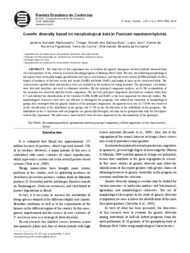Genetic diversity based on morphological data in Panicum maximum hybrids.
Genetic diversity based on morphological data in Panicum maximum hybrids.
Autoria: MARTUSCELLO, J. A.; BRAZ, T. G. dos S.; JANK, L.; CUNHA, D. de N. F. V. da; FONSECA, D. M.
Resumo: The objective of this experiment was to evaluate the genetic divergence between hybrids obtained from 10 sexual genitors of the Panicum maximum breeding program at Embrapa Beef Cattle. For this, the following morphological descriptors were used: plant height, growth habit, leaf aspect, leaf waxiness, hair density on the sheath (DePB) and blade (DePL), degree of hardiness of the hairs on the leaf sheath (DuPB) and blade (DuPL) and length of hairs on the sheath and blade. The characteristics growth habit and waxiness were not included in the analysis for being invariant. The phenotypic correlations were low and, therefore, not used to eliminate variables. By the principal component analysis, an 84.3% accumulation of the variation was observed until the fourth component. The last four principal components presented an estimate lower than 0.7 and allowed the identification of the variables DePB, DuPB and DuPL as the least important for diversity studies. The morphological characters used were not efficient to distinguish the progenies, but allowed the formation of morphological groups that converged with the graphic analysis of the principal components. An apparent error rate of 17.04% was observed in the classification of the individuals in the groups and 55.5% in the classification of the individuals in the progenies. The individuals in the P. maximum half-sib progenies are genetically divergent, but may not be grouped with only the descriptors used in this experiment. The pubescence characteristics were the least important in the discrimination of the genotypes.
Ano de publicação: 2012
Tipo de publicação: Artigo de periódico
Unidade: Embrapa Gado de Corte
Observações
1 - Por padrão são exibidas publicações dos últimos 20 anos. Para encontrar publicações mais antigas, configure o filtro ano de publicação, colocando o ano a partir do qual você deseja encontrar publicações. O filtro está na coluna da esquerda na busca acima.
2 - Para ler algumas publicações da Embrapa (apenas as que estão em formato ePub), é necessário ter, no celular ou computador, um desses softwares gratuitos. Sistemas Android: Google Play Livros; IOS: iBooks; Windows e Linux: software Calibre.
Acesse outras publicações
Acesse a Base de Dados da Pesquisa Agropecuária (BDPA) para consultar o acervo completo das bibliotecas da Embrapa.

